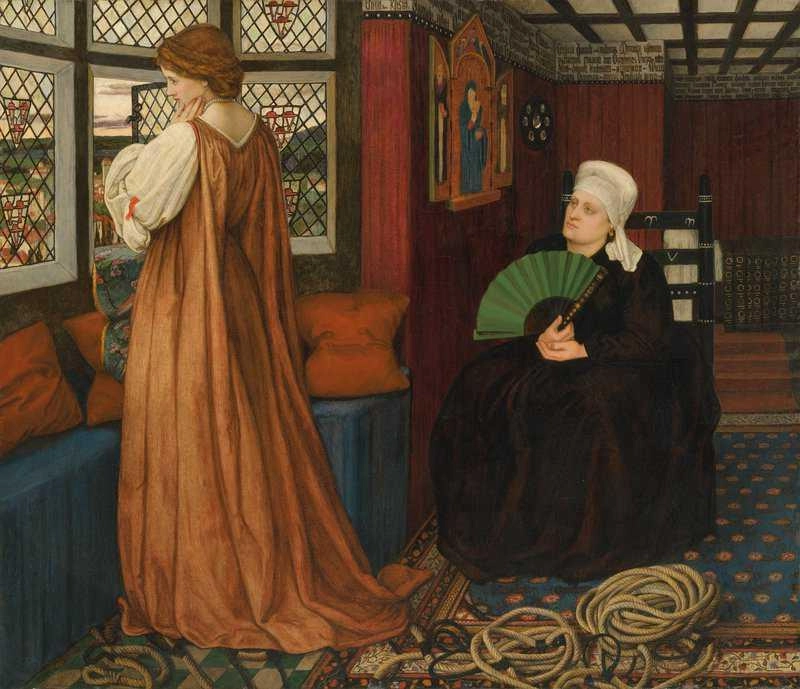

Hand painted reproductions of John Roddam Spencer Stanhope
John Roddam Spencer Stanhope: The Poet of Pre-Raphaelite Symbolism
John Roddam Spencer Stanhope (1829–1908) was a British painter whose work seamlessly blended the ideals of the Pre-Raphaelite Brotherhood with the ethereal mysticism of Symbolism. A key figure in the second generation of Pre-Raphaelites, Stanhope's art is characterized by its dreamlike beauty, meticulous attention to detail, and profound exploration of allegorical and mythological themes. His paintings evoke a sense of timeless wonder, transporting viewers into worlds where beauty and symbolism intertwine.
Early Life and Artistic Influences
Born into an aristocratic family in Yorkshire, England, Stanhope was exposed to art and culture from an early age. He initially studied at Oxford but soon shifted his focus to art, moving to London to train under the renowned Pre-Raphaelite painter George Frederic Watts. Watts’ mentorship, along with Stanhope’s close ties to Dante Gabriel Rossetti, Edward Burne-Jones, and other members of the Pre-Raphaelite circle, profoundly influenced his artistic development.
Stanhope was deeply inspired by the Pre-Raphaelites’ commitment to capturing beauty, truth, and nature through meticulous craftsmanship. However, his style evolved to incorporate a more symbolic and spiritual dimension, setting him apart from his contemporaries.
Artistic Style and Themes
Stanhope’s paintings are a fusion of Pre-Raphaelite precision and Symbolist imagination. His compositions are characterized by vibrant, jewel-like colors, intricate patterns, and a sense of otherworldly stillness. He often depicted biblical, mythological, and literary subjects, infusing them with symbolic meaning and emotional depth.
One of his most distinctive traits was his ability to depict female figures with a haunting, almost divine beauty. These figures, often draped in richly textured garments, exude an aura of grace, melancholy, and mystery. Whether portraying saints, muses, or mythological heroines, Stanhope imbued his subjects with a sense of spiritual transcendence.
In works such as The Waters of Lethe and Love and the Maiden, Stanhope explored themes of love, mortality, and the passage of time. His paintings invite viewers to contemplate the deeper, often hidden, meanings behind the visible world, making them both visually stunning and intellectually engaging.
Life in Italy and the Influence of Renaissance Art
In the 1870s, Stanhope moved to Italy, where he lived for the remainder of his life. The move marked a significant turning point in his career, as the influence of Italian Renaissance art became increasingly evident in his work. He was particularly drawn to the frescoes and mosaics of Florence and Rome, which inspired his use of luminous colors, harmonious compositions, and a refined sense of ornamentation.
Italy not only provided Stanhope with artistic inspiration but also allowed him to develop a more introspective and meditative approach to his art. His later works reflect a synthesis of Pre-Raphaelite romanticism and Renaissance classicism, creating a body of work that is both deeply personal and universally resonant.
Legacy and Recognition
Despite being overshadowed by more prominent members of the Pre-Raphaelite Brotherhood, Stanhope’s contribution to 19th-century British art is significant. His work embodies the transition from the Pre-Raphaelite focus on realism and nature to the Symbolist exploration of mysticism and the human psyche.
Stanhope exhibited at prestigious institutions such as the Royal Academy and the Grosvenor Gallery, and his paintings were highly regarded by critics and collectors alike. Today, his works are housed in major collections, including the Tate Britain, the Birmingham Museum and Art Gallery, and the Walker Art Gallery in Liverpool. His art continues to captivate audiences with its beauty, symbolism, and spiritual depth.
Own a Handcrafted Oil Painting Reproduction of John Roddam Spencer Stanhope’s Art
Bring the enchanting world of John Roddam Spencer Stanhope into your home with a handcrafted oil painting reproduction of his masterpieces. Each reproduction is meticulously crafted to capture the luminous colors, intricate details, and symbolic richness that define Stanhope’s art. Celebrate the legacy of this visionary artist and transform your space with a timeless work of art.
Imagine owning an original-style painting by one of the greatest artists in history. At POD, we offer you the chance to make this dream a reality. Each canvas is faithfully reproduced down to the smallest detail, allowing you to experience the beauty of the artist’s vision in your own home.
Our reproductions are crafted by experienced painters using the finest materials and time-honored methods. We are committed to delivering works of exceptional quality that will inspire and bring joy to your family for generations to come.
































